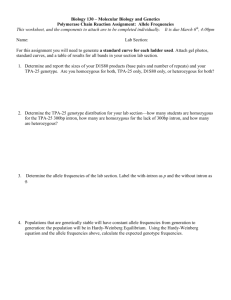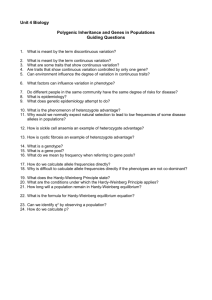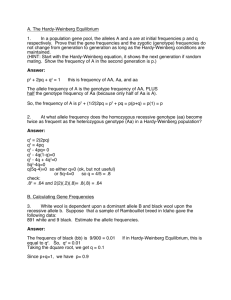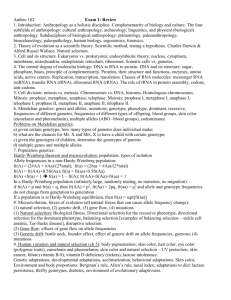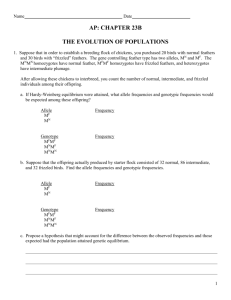Assignment 3
advertisement
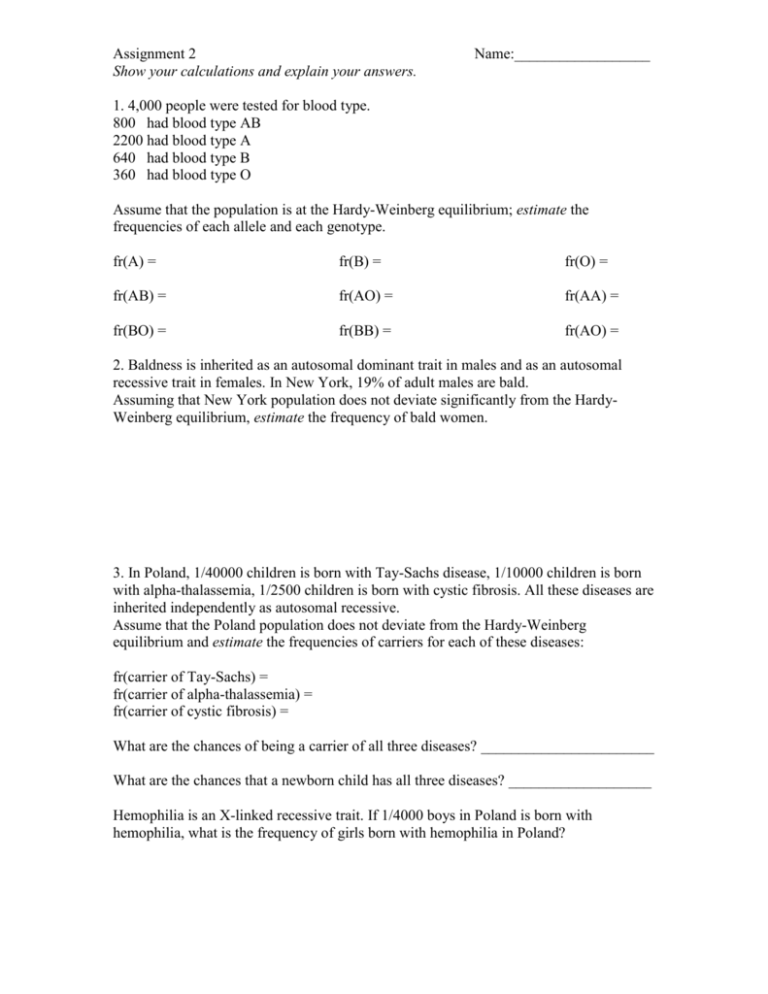
Assignment 2 Show your calculations and explain your answers. Name:__________________ 1. 4,000 people were tested for blood type. 800 had blood type AB 2200 had blood type A 640 had blood type B 360 had blood type O Assume that the population is at the Hardy-Weinberg equilibrium; estimate the frequencies of each allele and each genotype. fr(A) = fr(B) = fr(O) = fr(AB) = fr(AO) = fr(AA) = fr(BO) = fr(BB) = fr(AO) = 2. Baldness is inherited as an autosomal dominant trait in males and as an autosomal recessive trait in females. In New York, 19% of adult males are bald. Assuming that New York population does not deviate significantly from the HardyWeinberg equilibrium, estimate the frequency of bald women. 3. In Poland, 1/40000 children is born with Tay-Sachs disease, 1/10000 children is born with alpha-thalassemia, 1/2500 children is born with cystic fibrosis. All these diseases are inherited independently as autosomal recessive. Assume that the Poland population does not deviate from the Hardy-Weinberg equilibrium and estimate the frequencies of carriers for each of these diseases: fr(carrier of Tay-Sachs) = fr(carrier of alpha-thalassemia) = fr(carrier of cystic fibrosis) = What are the chances of being a carrier of all three diseases? _______________________ What are the chances that a newborn child has all three diseases? ___________________ Hemophilia is an X-linked recessive trait. If 1/4000 boys in Poland is born with hemophilia, what is the frequency of girls born with hemophilia in Poland? 4. In many mammals four-color is determined by two pigments: eumelanin (E) – black pigment and pheomelanin (P) – red pigment. Alleles for eumelanin and pheomelanin often function as co-dominant. In Ursus arctos arctos variation of fur-color is limited to three phenotypes: EE homozygous animals are black PP homozygous animals are red (auburn) EP heterozygotes are brown Flying in a helicopter over Siberia you spotted 500 ursi, 300 looked black 100 looked brown 100 looked red Find the frequencies of P and E alleles in the population of Siberian ursi: fr(P) = fr(E) = What genotype frequencies are expected for these allele frequencies, if the population does not deviate from the Hardy-Weinberg equilibrium? How many individuals are expected to have each genotype under the Hardy-Weinberg equilibrium? fr(PP)E = fr(PE)E = fr(EE)E = #PPE = ______________ #PEE = ______________ #EEE = ______________ Does this population deviate significantly from the Hardy-Weinberg equilibrium? (for 1 df and p=0.05, 2=3.84). Show all your calculations below: 5. Under Hardy-Weinberg equilibrium genotype frequencies are defined by allele frequencies. Fill-in the table and make a chart showing how genotype frequencies change with allele frequencies: fr(A)=p 0 0.1 0.2 0.3 0.4 0.5 0.6 0.7 0.8 0.9 1 fr(a)= 1-p fr(AA) =p2 fr(Aa) =2pq fr(aa) =q2 fr(A)= 00 fr(a)= 1.0 .1 .9 .2 .8 .3 .7 .4 .6 .5 .5 .6 .4 .7 .3 .8 .2 .9 .1 1.00 0.00 6. Find a recent, published within last 15 years, original study that employed HardyWeinberg theorem or its derivations. Summarize the goal of the study, the main hypothesis, and show how Hardy-Weinberg formulas were used to test this hypothesis.


